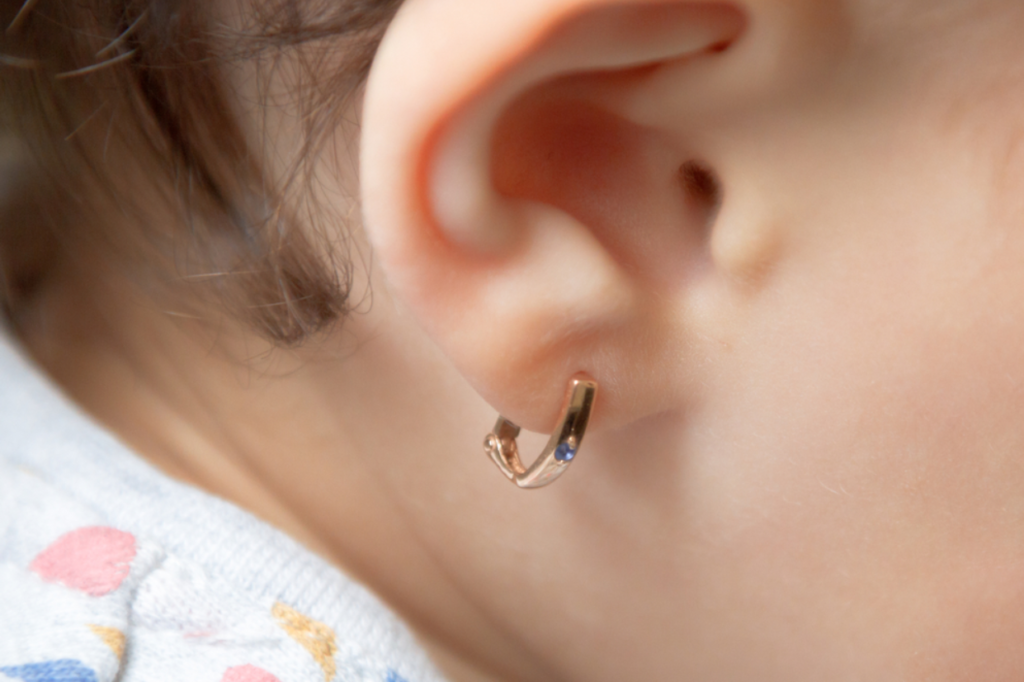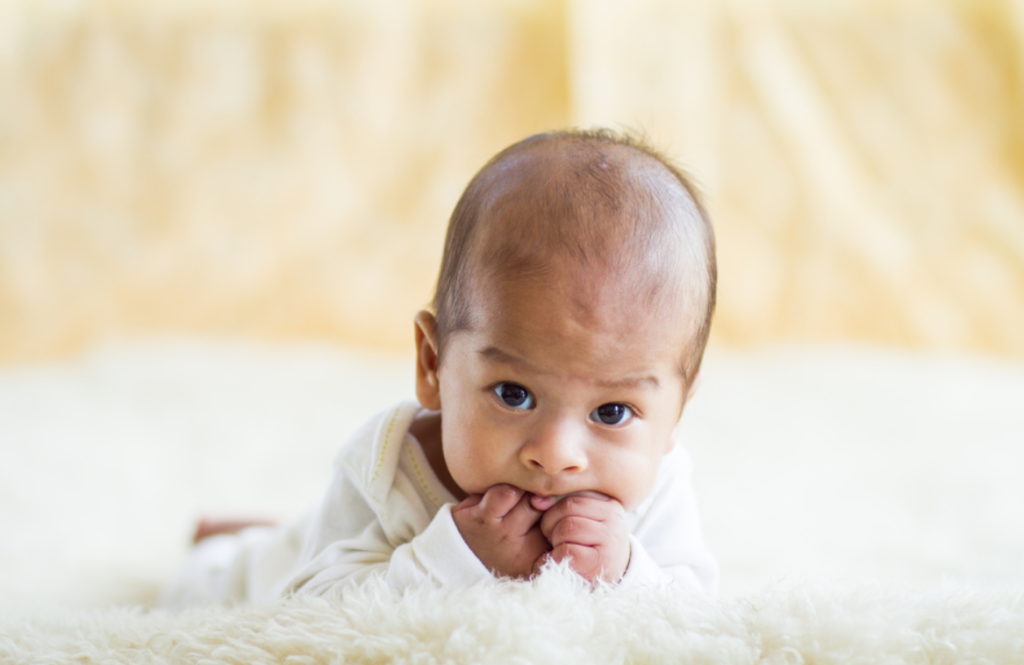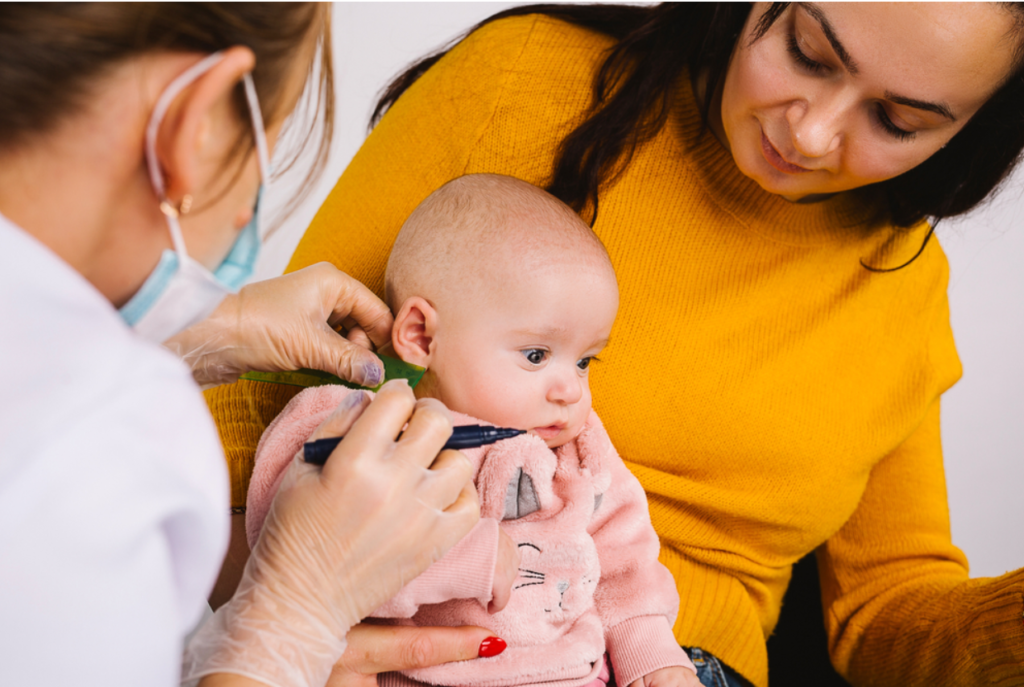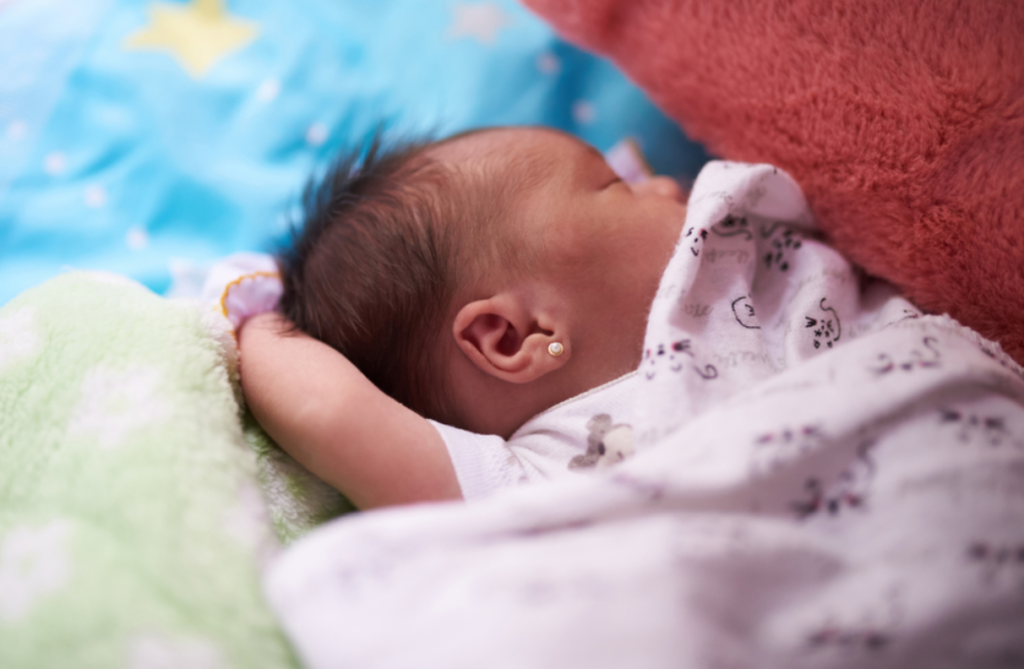Your baby’s ears are a lot like yours; made for hearing but with enough room to accommodate those cute piercings. These days, baby ear piercing has even become more common in many countries.
Of course, you may also be trying to figure out the best time to pierce your baby’s ears; do you want to wait until your little one is old enough to make personal choices? Or would you rather get it over with while your child is still a newborn?

No matter what side of the fence you sit on, this article is for you.
In this post, we’d walk you through the process of baby ear piercing; what it is, when to get it done, the possible complications, and things to note after piercing your baby’s ear. As a plus, we’ve added a section on essential tips for baby ear piercing.
Don’t Stop Reading!
Table of contents
Baby Ear Piercing
Yes, we know that the concept of baby ear piercing is a controversial one based on cultural, social, and religious variations. In fact, the American Academy of Pediatrics recommends waiting till your child is old enough to make the decision about ear piercing by him/herself.
However, it is important to note that this recommendation is more about allowing children make personal choices by themselves than the possibility of any health problem involved in the process.
Furthermore, the decision on when to pierce your baby’s ear also depends largely on the ability to reduce the possibility of an infection. Once this is sorted out, either by proper parental care or allowing the child grow old enough to care for his/her own ear, you’re good to go.
When to Peirce Your Baby’s Ear
Here’s the fact: There’s no perfect time to pierce your baby’s ear.
As we mentioned earlier, factors like culture and religion are also important roles in figuring out the best time to pierce your baby’s ear. In fact, we believe that the decision on when you pierce your child’s ear solely lies in your own hands.
Nevertheless, it is very important to consult your pediatrician before piercing your baby’s ear. Most doctors recommend waiting for about three months after birth before taking this step.
In addition, we also recommend waiting till your child has gotten the tetanus vaccine before getting their ears pierced. This would protect him/her from germs or infections associated with this process.
As a result, most parents believe that the best time to pierce your child’s ear is when he/she is about two months old.
Furthermore, at this age, children are still unable to identify the exact location on their bodies that is causing pain, so you don’t have to worry about them pulling the earring off to ease the pain.
Essential Tips for Baby Ear Piercing
1. Do It After Vaccination
As we mentioned earlier, two months after birth is a suitable time to pierce your baby’s ears because it coincides with your child’s first round of vaccine shots. This way, you get to shield your child from germs and reduce the possibility of infections.
2. Older Babies Can Localize Pain
By the time your child is about 6 months old, she can identify the specific location of body pain. As a result, she is more likely to tug the earrings in order to reduce the pain. To avoid this, the best option is to pierce your child’s ear after about 2 or 3 months of life.

3. Go for Gold
Studies show that babies do not react to pure gold earrings. If you can, go for 24 karat medical-grade gold-plated stud earrings to minimize the risk of an allergic reaction. Another safe option for baby earrings after piercing is sterling silver.
4. Keep an Eye Out for Infections
In the first few days after piercing your baby’s ear, you need to keep an eye out for any or all of the following signs:
- Pus-filled discharge
- Redness
- Tenderness
Most times, these are the tell-tale signs of a possible infection.
5. Use Sterile Equipment
This bit is very important.
While preparing to pierce your baby’s ears, it is super important to ensure that all equipment to be used is sterile and a qualified person is handling the process. In fact, some pediatricians agree to handle baby ear piercing in the confines of their office. This way, you’re assured of sterility and professionalism.

6. Don’t Take Off the Earrings
Weird right?
In the first six weeks after piercing your child’s ear, do not take off the new earrings. This would give the wound enough time to heal. In this period, you can prevent infections by cleaning the site regularly.
Possible Complications of Baby Ear Piercing
As we mentioned earlier, baby ear piercing is a unique procedure that may cause some complications if it is not done properly.
Some of these complications include:
- Allergic reactions
- Bleeding
- Infection
- Ear deformation
However, as long as you follow all the tips mentioned in this post and consult your pediatrician regularly, you don’t have to worry about these complications.
Things to Note After Piercing Your Baby’s Ears
If you’ve already taken the big step to pierce your baby’s ears, we’ve compiled a few important facts to note:
1. Allergies May Happen
In some rare cases, children may react to gold, which is a common material for earrings. As a parent, you can identify allergies in children by watching out for any of the signs mentioned earlier in this article. If you do notice any of these signs, please remove the earrings immediately and contact your pediatrician.
2. Aftercare Is Super Important
After piercing, you should care for your baby’s ears by cleaning and disinfecting the site regularly. This way, you’d reduce the risk of infection and help the wound heal faster.
3. Don’t Let the Jewelry Dangle
At this stage, right after a piercing, your child should only use stud earrings. With the right pair of studs, there’s no risk of the earring getting stuck on beddings on clothing. Furthermore, there’s no chance that your little one would pull it out.

Conclusion
Finally, it is important to remember that there’s no perfect time to pierce your baby’s ears. In fact, all you need to do is follow the tips in this post and your baby is going to be just fine. You can also read up on how to clean your baby’s ears for more helpful tips.
In addition, remember to consult your pediatrician before making a decision on how and when to pierce your baby’s ears.
We are always here to lend a helping hand.
References
Brandão MH, Gontijo B, Girundi MA, de Castro MC. Ear piercing as a risk factor for contact allergy to nickel. J Pediatr (Rio J). 2010 Mar-Apr;86(2):149-54. doi: 10.2223/JPED.1980. PMID: 20361123.
Lane JE, Waller JL, Davis LS. Relationship between age of ear piercing and keloid formation. Pediatrics. 2005 May;115(5):1312-4. doi: 10.1542/peds.2004-1085. PMID: 15867040.

